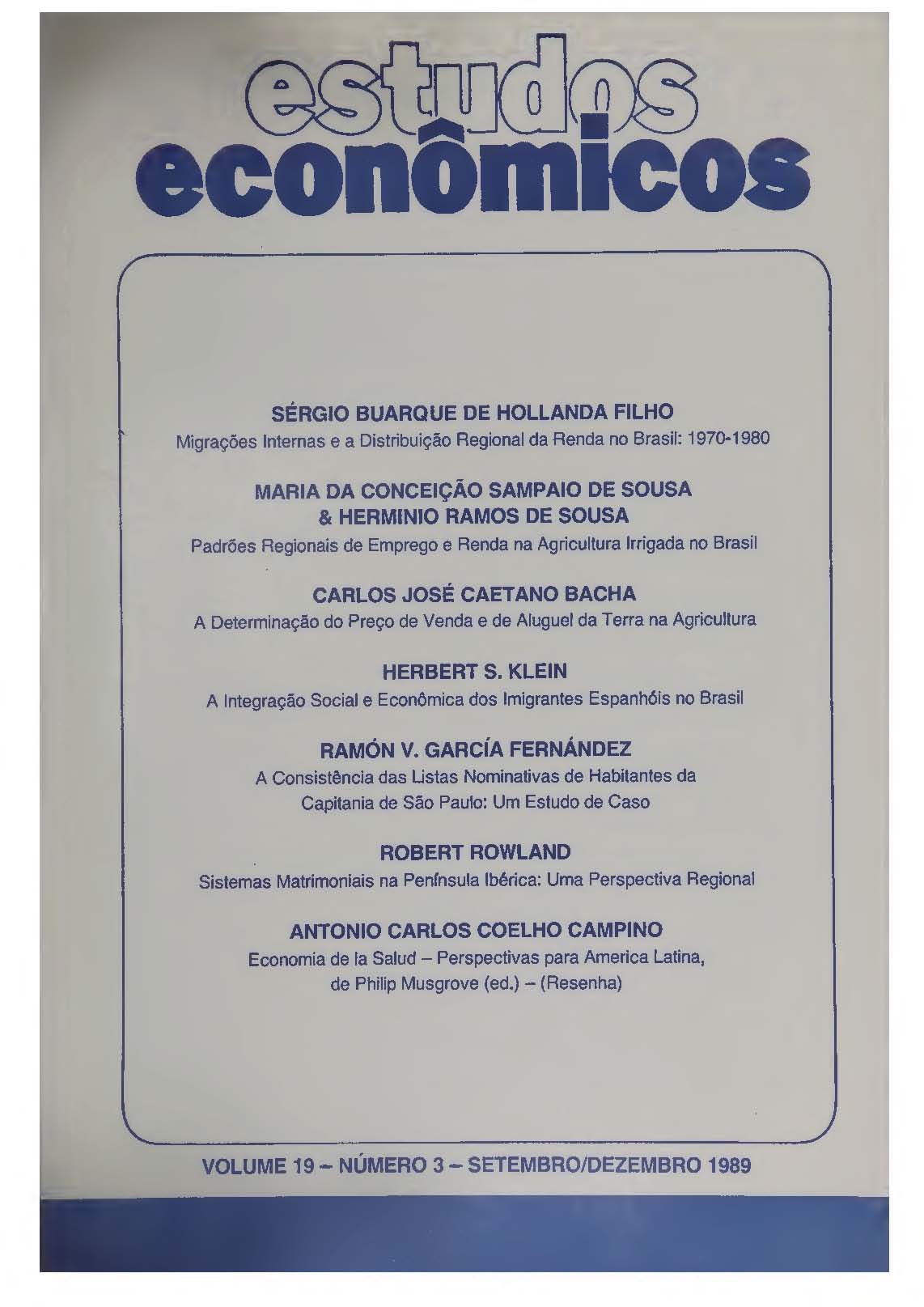Padrões regionais de emprego e renda na agricultura irrigada no Brasil
Keywords:
Irrigated agriculture, Employment, IncomeAbstract
The purpose of this study is to assess quantitatively the income and employment effects created by irrigation in Brazil. Special attention is given to the measurement of thei indirect effects generated through intersectoral dependency. Those impacts were estimated within an inputoutput framework and added to the direct effects in order to determinate total employment and income impacts. We distinguish between crops produced in the Northeast region from those produced in the! Brazilian Center-South to detectthe regional dimension of the effects analysed. We concluded that a) for every crop considered indirect effects are very strong; b) the indirect effects were higher in crops characterized by a higher labor productivity reflected by low direct employment coefficients; c) the indicator of direct employment is a poor indicator of the total employment principally in the Center-South region; e d) we could notfind an established relationship between income growth and employment creation.
Downloads
References
AHAMMED, C. J. & HERDT, R. W. Measuring The impacts of consumption linkages on the employment effects of mechanization in Philippine rice production. Journal ofDevelopment Studies,20{2):242-255,1984.
BELL, C. L, G. & HAZELL, P. B. R. Measuring the indirect effects of an agricultural project on its surroundings region. American Journal ofAgricultural Economics, 62(1): 75-86,1980.
BELL, 0. L. G. & DEVARAJAN, S. Towards a syntesis of semi-input-output and little-mirless: a social cost-benefit analysis with multiplier effects of an irrigation project in Nortwest Malaysia. Pakistan Development Review, 16(2): 165-185,1979.
CLARK, P. B. Intersectoral consistency and macroeconomic planning. In: BLITZER, C. R.;(CLARK, P. B. & TAYLOR, U (eds.). Economy-Wide models and development planning. Oxford, Oxford UniversityPress, 1975.
FUNDAÇÃO JOÃO PINHEIRO. Impactos macroecondômicos do PRONI. Belo Horizonte, Documento nº1, PRONI/FJP, 1987.
FUNDAÇÃO JOÃO PINHEIRO. Modelos-tipo de exploração agrícola irrigada. Belo Horizonte, Documento nº5, PRONI/FJP,
GARCIA, E. N. & MARFAn, M. Estruturas industriales y eslabonamientos de empleo. Santiago do Chile, Prealc/OIT, 1982.
JOHNSTON, B. F. & KILBY, P. Agricultural and structural transformation. New York, Oxford University Press, 1975.
MAFFEI, E. & RAMOS DE SOUZA, H. Irrigação e emprego no Sudeste do Brasil: os casos de Barretos Guafra (São Paulo) e Paracatu - São Gotardo (Minas Gerais). Recife, OIT/PNUD/PRONI, 1987.
MAFFEI, E.; FERREIRA IRMãO, J. & RAMOS DE SOUZA, H. Irrigação e emprego no sertão de São Francisco. Recife, OIT/PNUD/SUDENE, 1986.
MARFAN, M. Metodologia para estimar el impacto indireto sobre el empleo de la agricultura irrigada en Brasil. Informe de Consultoria, Projecto BRA-82/021, Convênio OIT/PNUD/SUDENE, dez. 1986.
MELLOR, J. W. The new economics of growth. Ithaca, N. Y., Cornell University Press, 1967.
RAMOS DE SOUZA, H. Diferenças regionais no emprego: considerações em torno da agricultura irrigada no Brasil. In: Divisão inter-regional do trabalho no Brasil. CAEN/CEDEPLAR, UFCE/UFMG (no
prelo).
RAMOS DE SOUZA, H. A Irrigação e os impactos diretos sobre o emprego. Trabalho intemo do PIMES, s/d. ROESLER, T, W.;| LAMPHEAR, F. C. & BEVERIDGE, M. D. The economic impact of irrigated agriculture on the economy of Nebraska. Nebraska Economic and Business Reports, nº 4. University of Nebraska, set. 1968.
SAMPAIO DE SOUSA, M. C. & RAMOS DE SOUZA, H. Impactos econômicos da irrigação: uma análise de insumo-produto. Recife, Relatório de Pesquisas, nº 9, Convênio PRONI/UFPE, jun, 1988 (versão prellmlnar).
STERN. J. J. & LEWIS, J. D. Employment patterns and income growth. Washington, D. C., World Bank Staff Working, Paper nº 419,1980.
Downloads
Published
Issue
Section
License
Copyright (c) 1989 Maria da Conceição Sampaio de Sousa, Herminio Ramos de Souza

This work is licensed under a Creative Commons Attribution-NonCommercial 4.0 International License.
By submitting an article, the author authorizes its publication and attests that it has not been submitted to any other journal. The original article is considered final. Articles selected for publication are proofread for grammatical and orthographic errors. The journal does not pay rights for published articles. The Institute of Economic Research from the School of Economics, Business and Accounting of the University of São Paulo (Instituto de Pesquisas Econômicas da Faculdade de Economia, Administração e Contabilidade da Universidade de São Paulo) owns the journal's copyright.




